Dr. Likover, a leading knee surgeon, performs arthroscopic ACL knee surgery in Houston to restore knee stability in patients with a tear of the anterior cruciate ligament, the most common major ligamentous tear of the knee.
Table of Contents
- ACL Injury Symptoms
- Effects of Injured ACL
- ACL Reconstruction for Athletes
- Arthroscopic ACL Reconstruction
- Recovery After ACL Reconstruction Surgery
- ACL Surgery Videos
- Testimonial
- Schedule An Appointment
ACL Injury Symptoms
When a person tears their ACL, they usually say that the “knee popped out” or the “bone moved.” Subsequently, the injured person develops a swollen, painful knee because the ligament bleeds when it tears and fills the knee with blood.
Over a period of time, the blood disappears and the pain diminishes; the knee, however, remains unstable. The anterior cruciate ligament is a very important knee ligament for the stability of the knee. It is basically a “cable” or “rope,” and a tear of this ligament usually causes significant instability or looseness of the knee.
Effects of Injured ACL
Knee instability resulting from an injured ACL can severely affect the future function of the knee joint for sports requiring changing direction and work activities requiring lifting, climbing, and straining.
Further Injury Possible If Left Untreated
Once the knee becomes unstable as a result of ligamentous injury, the knee joint is much more prone to further injury, such as tearing one or both of the cartilages (menisci) and the development of loose bodies or arthritis over a period of time.
Overall, the knee has a tendency to deteriorate significantly if it remains unstable if the initial ligament injury is not treated properly.
Without ACL Surgery, 80% of Patients Develop Significant Secondary Problems
Orthopedists estimate that only about twenty percent of people who tear their anterior cruciate ligament and do not have surgical treatment do well over the years.
Eighty percent of the people who tear their anterior cruciate ligament and who leave it untreated will develop significant secondary problems with their knee requiring various surgical procedures.
Secondary problems include the development of torn cartilages, loose bodies, arthritis, or a painful knee. Women tend to do worse with an untreated anterior cruciate ligament injury than do men.
ACL Reconstruction for Athletes
For athletic individuals who wish to continue playing vigorous sports and other high demand activities, ACL reconstruction should be performed to restore knee stability. If one feels that his or her athletic career is near its end and they have become less active, then ACL surgery is not required.
Dr. Likover does not recommend continuing to play sports on an unstable knee, as it has been shown repeatedly that the knee will go on to develop multiple problems as a result of the instability. Professional and high levels always get their ACL tear fixed.
Arthroscopic ACL Reconstruction
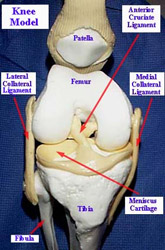
Arthroscopic anterior cruciate reconstruction is a major advancement in the treatment of an acute or chronic tear of the anterior cruciate ligament.
Since 1987, arthroscopic technology has advanced to allow for ligament reconstruction of the knee without cutting the knee open.
Dr. Likover was one of the first orthopedists in Houston to perform this type of procedure, and since 1987 he has performed over 1,200 of these procedures.
About the Procedure
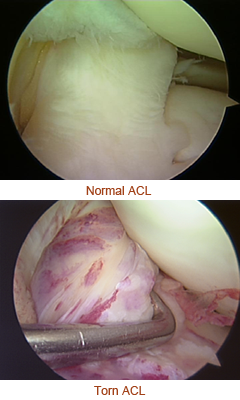
At the time of surgery prior to reconstruction of the ligament, a complete diagnostic arthroscopy of the knee is performed. All other damage, including torn cartilages, bone chips, or any other problem within the knee, are repaired prior to ligament reconstruction.
Through the use of arthroscopy, a new anterior cruciate ligament can be made for the knee and be placed within the knee joint without making a large cut on the knee. A two-inch skin incision and three arthroscopy cuts are used to perform this operation.
The procedure, as developed by Dr. Likover, allows him to make small, pleasing cosmetic incisions. Drill holes are placed within the bone, and the new ligament is held in place with dissolving screws. The surgeon and patient have a choice of the material used to reconstruct the anterior cruciate ligament.
ACL Tissue Replacement Options
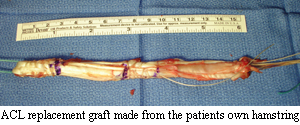
The goal of the operation is to replace the torn ACL ligament, which is not repairable, with a new ligament made out of material that can last a lifetime. Human tissue is currently the only replacement tissue with the potential to last this long.
For a first-time reconstruction of the ACL, most orthopedic surgeons in the United States treating high-level and professional athletes recommend using the patient’s own tissues for reconstructing the ligament.
ACL Grafting: Bone-Patella Tendon-Bone (BPTB) vs Quadriceps Tendon
As of 2023, there are two options for reconstruction of the ACL in athletic individuals:
- Bone-patellar tendon-bone autograft (BPTB), or
- Quadriceps tendon autograft.
Autograft means using the tissue in your own leg and making that tissue into a new ACL ligament and placing it in the knee.
Both grafts are large and extremely strong. The success rate of either procedure is excellent. However, BPTB is known in some patients to cause persisting pain in the front of the knee (anterior knee pain syndrome).
This problem is not the case with quadriceps tendon grafts. For this reason, Dr. Likover has switched to using quadriceps tendon. It also seems quad tendon patients have less pain and recover quicker than BPTB patients.
Hamstring tendons are no longer used by Dr. Likover, as the results are not as good as with BPTB or quadriceps tendon grafts.
Cadaver Allograft (Using Deceased Donor Tissue)
Cadaver allograft for younger athletic individuals (under 25 years of age) generally should not be used, several studies have shown.
Cadaver allograft (from a dead person) bone-patella tendon-bone graft is occasionally a choice to use for older individuals who are not that athletic and just desire some restoration of knee stability.
Cadaver allograft is also used for a failed ACL reconstruction in some cases as a second procedure.
The arthroscopic technique for anterior cruciate ligament reconstruction allows this procedure to be performed as an outpatient procedure.
Recovery after ACL Reconstruction Surgery
The patient may start riding a stationary bicycle or use a StairMaster less than one week following the surgery. Walking with weight bearing and the use of crutches is started immediately following the surgery. Gradually the patient adjusts to one crutch, and then is crutch-free, as tolerated.
Physical Therapy
Some individuals go to physical therapy after surgery; others do their own therapy. While it is not mandatory to go to a physical therapist, it is mandatory to exercise the knee regularly for a significant period of time following the procedure.
Continuous Passive Motion (CPM) Therapy
Dr. Likover recommends the use of a continuous passive motion machine (CPM) immediately following the surgery to recover range of motion to the knee. Most insurance companies cover the cost of home rental of the CPM. If not, it can be rented through a medical equipment company.
Dr. Likover recommends Therapeutic Solutions at 281-922-5453.
In addition, to obtain full bending of the knee with the CPM machine, the post-operative patient must work especially hard to regain full extension of the knee. If the full range of motion of the knee is achieved, the result of this type of surgery is excellent.
How Long Does Recovery Take?
It generally takes six to nine months to fully rehabilitate the knee following ACL reconstruction surgery.
High-velocity contact sports such as football, basketball, volleyball, or downhill skiing are usually allowed at 9 months following the surgery. This delay in time gives the new ligament a chance to develop a new blood supply and become strong.
ACL Surgery Videos
The 6 videos below depict an actual ACL surgery performed in Houston by Dr. Likover.
Testimonial from E.Mike Spartalis, from Sugar Land, Texas
On March 7, 2012 I celebrated my 64th birthday. I am an active older guy (age is only a number) who lives vicariously through his sports, competition and my sons. Softball, tennis, skiing and especially Basketball have been my release, my therapy and my passions. If Basketball were a woman, I would be having an affair.
I thank my God for the ability to play these games and also for putting Dr. Larry Likover in my life. Over 20 years ago after suffering a torn ACL from skiing and two unsuccessful knee surgeries, I was faced with a future without my most precious therapeutic sports and passions.
Dr Likover was referred to me and after our initial visit, I knew this doctor’s bluntness, quickness to diagnose my situation, his history, his reputation as a great Knee surgeon and his passion for his profession was the person I needed. You could say he was “Exactly what the Doctor ordered” or in this case what God ordered.
I had the reconstruction surgery on my right knee and my history from that time to present has been playing in multiple national and local championships in softball, going on weekly Basketball games playing at a competitive level, skiing and active athletic challenges with my athletic sons.
I recently was awarded an “Athletic Spirit Award” from a local sports radio station for my achievements and continuous efforts to play the sports of my passions at this sobering age. I thought about what led me to this award and my thoughts focused on Dr. Likover’s success in repairing my knee. For this Lifetime passion that has not eluded me, I give thanks for a doctor who cared enough about whom I was and my passions. Although I did not make millions playing a sport, it was worth millions or let’s say priceless, to me to continue to play. To a dedicated professional who always takes his medical knowledge and his unique bedside manor to the next level, thank you Dr. Likover, you’re the best.
E. Mike Spartalis
Schedule An Appointment
Contact our office to schedule an evaluation today or get answers to your questions. You can reach us via phone at (713) 465-0696 or schedule an appointment online.
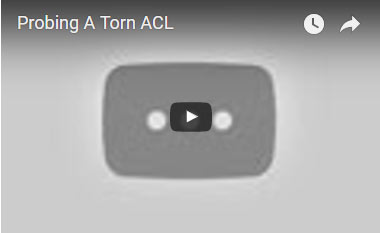
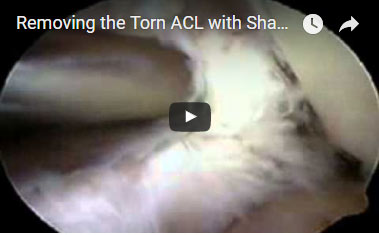
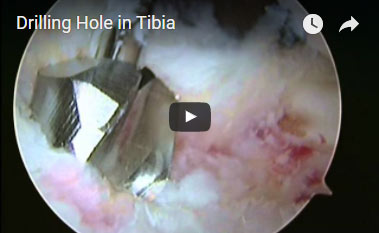
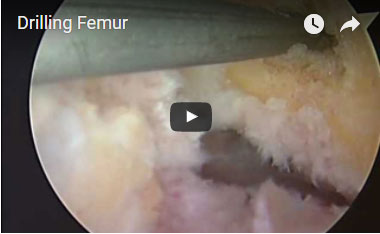
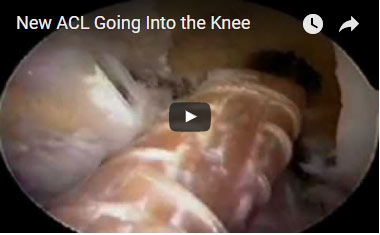
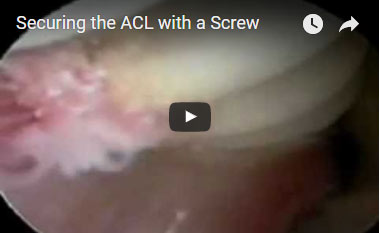
 Dr. Larry Likover has been practicing orthopedics on the west side of Houston for 43 years, treating knee, hip, shoulder, and back problems. Dr. Likover is board certified in orthopedic surgery and provides knee replacement in Houston for patients worldwide.
Dr. Larry Likover has been practicing orthopedics on the west side of Houston for 43 years, treating knee, hip, shoulder, and back problems. Dr. Likover is board certified in orthopedic surgery and provides knee replacement in Houston for patients worldwide.